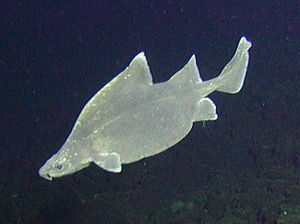Prickly sea sow
| Prickly sea sow | ||||||||||||
|---|---|---|---|---|---|---|---|---|---|---|---|---|

Prickly sea sow ( Oxynotus bruniensis ) |
||||||||||||
| Systematics | ||||||||||||
|
||||||||||||
| Scientific name | ||||||||||||
| Oxynotus bruniensis | ||||||||||||
| ( Ogilby , 1893) |
The prickly sea sow ( Oxynotus bruniensis ) is a species of the pig sharks (Oxynotidae) within the dogfish-like (Squaliformes).
features
The prickly sea sow reaches a body length of a maximum of about 70 centimeters. Like all species of the family, it has a very high-backed body with a triangular cross-section, so that there are lateral keels between the pectoral and pelvic fins. The coloration of the sharks is uniformly gray-brown without noticeable markings or markings, occasionally the tips of the dorsal fins can be translucent or white.
The muzzle is short and blunt. The two dorsal fins are very high and sail-like, in front of each there is a strong spike, with the first spike pointing backwards. One anal fin is missing. There is a small and round spray hole in front of the gills . The skin is very rough due to the existing placoid scales , which is why the shark got its common English name "Prickly Dogfish", from which the German name "Stachelige Meersau" is derived. The teeth of the upper jaw are lanceolate, the lower ones pawl-like; the latter are in less than 12 rows side by side.
distribution and habitat
The prickly sea sow is the only species of the family found in the western Pacific in the waters on the south coast of Australia from Newcastle , New South Wales to the Great Australian Bay and south of Tasmania as well as around New Zealand , Chatham Rise and the Chatham Islands .
The shark lives above the area of the continental shelf and on the continental slopes near the bottom to a depth of about 500 meters. According to other sources, the shark occurs off New Zealand to a depth of 1050 meters and is usually found between 350 and 650 meters water depth.
Way of life
Little information is available about the way of life of this species. The shark likely feeds on bottom-dwelling invertebrates and smaller fish. The high-backed shape represents an adaptation to the sharks' way of life near the ground.
It is viviparous ( ovoviviparous ), but does not form a yolk sac placenta . The number of young animals is around seven and the size during birth is around 25 centimeters. The males reach sexual maturity with a body length of about 60 centimeters, the females with about 67 centimeters.
Hazard and protection
The prickly sea sow is not deliberately fished commercially, but can be caught as bycatch in the trawling fishery . Specific catch data are not available for this species. Due to the limited amount of data available, the shark is classified as “data deficient” in the IUCN's Red List of Endangered Species .
supporting documents
- ↑ a b c d e f g Oxynotus bruniensis on Fishbase.org (English)
- ↑ a b c Prickly Dogfish, Oxynotus bruniensis (Ogilby, 1893) Australien Museum, accessed March 20, 2011.
- ↑ a b c Oxynotus bruniensis ( Memento of the original from March 4, 2016 in the Internet Archive ) Info: The archive link was inserted automatically and has not yet been checked. Please check the original and archive link according to the instructions and then remove this notice. at the Shark Foundation.
- ↑ a b c d Oxynotus bruniensis in the endangered Red List species the IUCN 2010. Posted by: Francis, MP (SSG Australia & Oceania Regional Workshop, March 2003), 2003. Accessed March 20, 2011th
Web links
- Oxynotus bruniensis on Fishbase.org (English)
- Oxynotus bruniensis at the Shark Foundation.

